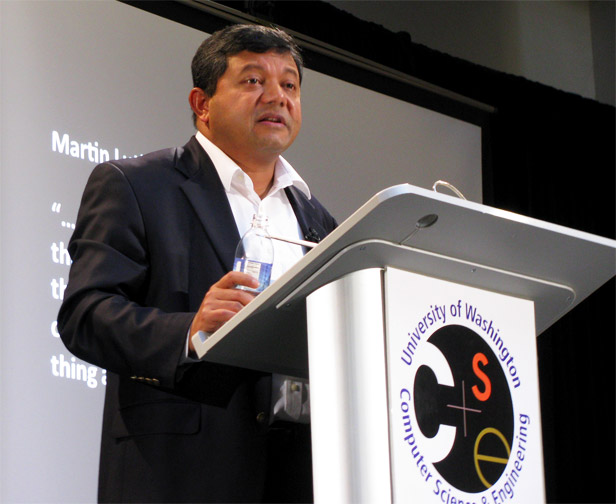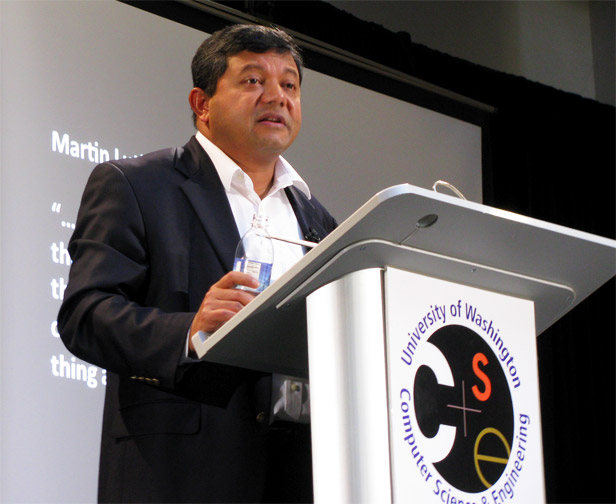 Arun Majumdar, director of the Advanced Research Projects Agency-Energy, spoke at the University of Washington last Friday on the need to fund ambitious energy research.Grist photo/Jonathan Hiskes
Arun Majumdar, director of the Advanced Research Projects Agency-Energy, spoke at the University of Washington last Friday on the need to fund ambitious energy research.Grist photo/Jonathan Hiskes
When the Soviet Sputnik beat American satellites into space in 1957, the U.S. tried to reclaim its technological edge by creating the Defense Advanced Research Projects Agency, which pursued high-risk, high-payoff tech breakthroughs. DARPA contributed to the creation of GPS, speech-recognition algorithm … and the internet.
One could say the U.S. is facing three energy Sputniks now—its foreign-oil dependence, its diminishing technological lead, and climate change. Energy Secretary Steven Chu hopes that a new agency modeled after DARPA–Advanced Research Projects Agency-Energy–will bring similar breakthroughs in the energy field. He placed a former colleague from Lawrence Berkeley National Laboratory, mechanical engineer Arun Majumdar, in charge of ARPA-E. Last fall the agency awarded $400 million in stimulus-act funding to 37 projects (see a list). Another round of funding will be announced in April.
Majumdar visited Seattle last week to talk energy with Bill Gates, meet with venture capitalists, and speak at the University of Washington Department of Computer Science & Engineering. I caught up with him after his speech for an interview in the back of a decidedly non-high-tech minivan.
Q. What advances in energy technology are you excited about these days?
A. Storage. Let’s say we create battery technology that improves hybrid electric vehicles. You can then use electricity to run our cars, and that becomes part of our energy security. The other part is carbon-capture technology for coal.
Storage in general is a huge missing piece in the grid today. If you can get it cost effectively, that’s a game-changer.
Q. You’re funding some storage-related projects?
A. We are. We thought it would be useful to have a little competition with those people that we invested in. So we had a workshop on storage to see what else is out there. And there are some very interesting things out there. We might be investing in them later on.
Q. So what stocks should our readers be buying?
A. [Laughs] No comment.
Q. You mentioned that only 10 or 15 percent of ARPA-E projects might succeed. That’s a low success rate.
A. It’s a rough number. It’s certainly not going to be 90 percent succeeding, because we are aiming for transformational ideas.
Q. How do you explain to the public why it’s important to make these high-risk investments?
A. I’ll use a quote by Wayne Gretzky: “You miss 100 percent of the shots you don’t try.” So we’ve got to try. If you look back in history at what the best entrepreneurs and technologists have done, it’s not that they’ve never failed. When you ask the best, most famous people, you learn they have failed. But they have failed and learned quickly from it. That’s what we want the teams to do.
Q. Let’s talk nuclear energy. Did you see something change that led President Obama to talk up nuclear in the State of the Union and announce loan guarantees for new reactors in Georgia this month?
A. The president has said very clearly that nuclear power is clean and has to be part of our mix. It’s something we invented and it produces 20 percent of [U.S.] electricity today. If you don’t do anything, that percentage will go down, but we want to increase it.
Q. The simple argument against nuclear power is that private investors don’t want to touch it, only governments will invest in it, and that this should tell you everything you need to know about its viability.
A. That’s not quite true. Loan guarantees are essentially to get someone to put up the loan. One of the projects in the [Department of Energy’s] Office of Nuclear Energy is to extend the life of nuclear plants that were going to be decommissioned, because they have recuperated the initial investment, and now they’re money-makers.
Another idea is that there are coal-fired power plants that will be decommissioned someday. If you build a nuclear plant in the same location as a coal plant, you don’t have to worry about the cost of transmission lines. The infrastructure is already there.
Q. What’s the future for rooftop solar and other forms of distributed energy, or local energy?
A. The question is cost. If the cost of rooftop photovoltaic [solar] drops and the fully installed price comes down, I think we’ll see a lot of that happen. On the regulatory front, with siting and licensing issues, distributed energy is much easier. If you put up a hundred-megawatt solar plant, you need to get all kinds of permits. There’s a cost to that.
Q. You’ve got a department called ‘Marketing and Decision Science.’ What’s that about?
A. We can and should do a lot of supply-side energy–generation, photovoltaic, biofuels, etc. But the other side of energy is demand. How do people use energy and how do we provide information so that they use it in a different way? That’s something I’m quite interested in and I haven’t thought through very deeply, but we’re looking for innovative ideas out there.
Q. You mentioned in your talk that, with DARPA, there was a buyer right there in the Department of Defense. With energy, you’ve got to figure out who the buyer is going to be.
A. That’s a complex challenge, but I like complex challenges. The secretary and all of our senior leadership are very interested in looking at this.
Q. I always hear that Silicon Valley culture is action-oriented and responsive, and you learn things and change course quickly. Washington’s reputation is different. What’s the transition been like?
A. I have to wear a tie. I have been in academic and research culture which happens to be in Silicon Valley and it’s hard to avoid investment communities out there. But I’ve worked with the secretary in the past and he has given his 100 percent support for ARPA-E. Without that kind of support, perhaps I would have just stayed back in Berkeley.
The other thing that is very rewarding is that I get to see some amazing ideas being proposed. I never got to see that being in an academic institution or a national lab. And I’m very optimistic from what I’m seeing. If we can get a few of those innovations to a maturity level that can then balloon and blossom in the private sector, we would really be in great shape. So that is very rewarding.
Q. If you could wave a wand and instantly change one thing about the political structure, what would it be?
A. I don’t want to change political structures. I don’t understand politics–I’m a techie. I’m serving the nation and after a few years, I’ll go back and be a scientist and engineer.
This is a condensed and edited version of the interview, which took place on Feb. 18.


